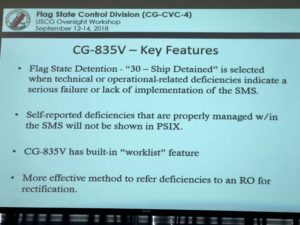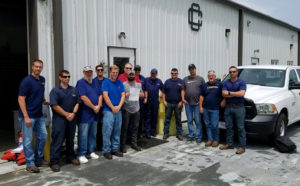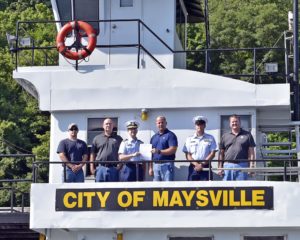USCG Oversight Workshop
This week TVIB’s staff participated in the first annual USCG Oversight Workshop at Sector Houston-Galveston. The newly formed Flag State Control Division CG-CVC-4, headed up by CDR Michael Simbulan, put together a 3-day workshop. In his opening remarks, RADM John P. Nadeau, Assistant Commandant for Prevention Policy, told the USCG personnel in attendance that they are charged with being “ready, relevant and responsive.” He finished his comments by telling all in attendance “We’re in this together. TPO failure is Coast Guard failure. Their success is our success.” TVIB staff took this as a very encouraging sign and believe it’s to our mutual benefit to establish solid working relationships.
“We’re in this together. TPO failure is Coast Guard failure. Their success is our success.” RADM John P. Nadeau, U.S. Coast Guard Assistant Commandant for Prevention Policy
The first day was attended by TPOs, classification societies and USCG marine inspectors from around the country. The next two days were scheduled for the marine inspectors only, to conduct training on the oversight activities of CG-CVC-4. This division was stood up as a result of the investigation from the El Faro and the need for increased oversight for third parties that conduct activities on behalf of the Coast Guard. The oversight responsibilities of this new division are much broader than Subchapter M.
 TVIB was asked to discuss Subchapter M from a TPO Perspective. Chris Parsonage, Executive Director for TVIB, addressed the role of a TPO, TPO responsibilities, the survey and audit reports and their function as objective evidence, and the relationship between the TPO and the USCG. Chris finished with the benefits of the TSMS option such as improving safety and operational effectiveness as well as the recently highlighted opportunity for TSMS option vessels to request their TPO to clear deficiencies noted on a CG-835V. We’ll be working directly with our TPO customers in the coming days to ensure they know how to take benefit of this option. Calling on your TPO to clear a deficiency is likely to expedite the process of clearing out deficiencies if an operator does not have to wait on a marine inspector. Our auditors and surveyors are generally available and willing to go out when called.
TVIB was asked to discuss Subchapter M from a TPO Perspective. Chris Parsonage, Executive Director for TVIB, addressed the role of a TPO, TPO responsibilities, the survey and audit reports and their function as objective evidence, and the relationship between the TPO and the USCG. Chris finished with the benefits of the TSMS option such as improving safety and operational effectiveness as well as the recently highlighted opportunity for TSMS option vessels to request their TPO to clear deficiencies noted on a CG-835V. We’ll be working directly with our TPO customers in the coming days to ensure they know how to take benefit of this option. Calling on your TPO to clear a deficiency is likely to expedite the process of clearing out deficiencies if an operator does not have to wait on a marine inspector. Our auditors and surveyors are generally available and willing to go out when called.
TVIB staff also had the opportunity for a one-on-one conversation with RADM Nadeau where we were able to communicate issues that we face as a TPO as well as those faced by our TPO customers. This presented an opportunity to advocate for a simplified COI application process that would be used consistently from district to district and OCMI to OCMI. We are preparing a marked-up vessel particulars document in hopes of streamlining the data collection activity for the marine inspector by eliminating questions that are not relevant to inland towing vessel operations or helping to clarify terminology.
TVIB appreciates the opportunity to participate in this forum. We had access to leadership from the TVNCOE with CDR Andrew Bender and CG-CVC with Capt. Matt Edwards. Any time we can get together to share concerns and develop strategies we increase understanding all around. This forum presented us with an opportunity to put faces to names for many of the sector and unit personnel we regularly work with. We thank all of our industry partners and the marine inspectors that came in for this session.

 On June 27th, Crounse’s vessel the M/V Eva Kelley, was the first vessel in their fleet to receive their Certificate of Inspection (COI). Dylan Hesley, Manager of Safety, along with the shoreside team and the crew of the M/V Eva Kelley worked with MSU Paducah in submitting the required information for the COI application and getting the vessel ready for the inspection. Civilian Marine Inspector Joseph Brown said, “It is definitely a process to gather all of the required information needed for objective evidence but with constant communication between the vessel rep and the Coast Guard it can be relatively painless.” He went on to encourage companies to begin conversations with their local USCG Marine Inspectors and submit their vessel particulars as soon as possible. Submitting these details up front allows the local unit to build the vessel profile in the Coast Guard’s Marine Information for Safety and Law Enforcement (MISLE) system and move on to the step of reviewing objective evidence. Mr. Brown noted that reviewing the objective evidence takes considerable time on their part. TVIB recommends contacting each unit where a company will apply for a COI to determine their specific requirements as the USCG has not adopted a single standard. This was the first COI issued by Marine Safety Unit Paducah.
On June 27th, Crounse’s vessel the M/V Eva Kelley, was the first vessel in their fleet to receive their Certificate of Inspection (COI). Dylan Hesley, Manager of Safety, along with the shoreside team and the crew of the M/V Eva Kelley worked with MSU Paducah in submitting the required information for the COI application and getting the vessel ready for the inspection. Civilian Marine Inspector Joseph Brown said, “It is definitely a process to gather all of the required information needed for objective evidence but with constant communication between the vessel rep and the Coast Guard it can be relatively painless.” He went on to encourage companies to begin conversations with their local USCG Marine Inspectors and submit their vessel particulars as soon as possible. Submitting these details up front allows the local unit to build the vessel profile in the Coast Guard’s Marine Information for Safety and Law Enforcement (MISLE) system and move on to the step of reviewing objective evidence. Mr. Brown noted that reviewing the objective evidence takes considerable time on their part. TVIB recommends contacting each unit where a company will apply for a COI to determine their specific requirements as the USCG has not adopted a single standard. This was the first COI issued by Marine Safety Unit Paducah. On July 13th, the M/V City of Maysville was the second Crounse vessel to receive a COI. Mike Kidd, Port Captain, worked with the vessel’s crew and MSU Huntington to obtain the vessel’s COI. U.S. Coast Guard Commander Paul Mangini had this to say “The Coast Guard appreciates the dedication, diligence and willingness of the Crounse Corporation to put the effort in to achieve compliance with Subchapter M and supply the necessary information in order to generate the first Certificate of Inspection for the City of Maysville in the Port of Huntington/Tri-State zone. We look forward to continued cooperation as we both work together to bring the rest of their towing vessel fleet into inspected status.” This was the first COI issued by Marine Safety Unit Huntington.
On July 13th, the M/V City of Maysville was the second Crounse vessel to receive a COI. Mike Kidd, Port Captain, worked with the vessel’s crew and MSU Huntington to obtain the vessel’s COI. U.S. Coast Guard Commander Paul Mangini had this to say “The Coast Guard appreciates the dedication, diligence and willingness of the Crounse Corporation to put the effort in to achieve compliance with Subchapter M and supply the necessary information in order to generate the first Certificate of Inspection for the City of Maysville in the Port of Huntington/Tri-State zone. We look forward to continued cooperation as we both work together to bring the rest of their towing vessel fleet into inspected status.” This was the first COI issued by Marine Safety Unit Huntington.